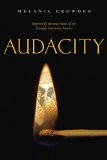Summary | Excerpt | Reviews | Beyond the book | Read-Alikes | Genres & Themes | Author Bio

The Game is pretty simple. Death picks her player at birth. Love picks his. They wait until a prescribed time when their players must choose to allow the love they feel for one another to be realized – or not. If they do choose love, well, then Love wins the game. But if they don't…then Death wins. And with her win comes the price of one player's life. This is the game that has been played by Love and Death through eternity.
Flora and Henry are the chosen players in Martha Brockenbough's incredibly inventive and vibrant young-adult novel, The Game of Love and Death. The time is 1937, the place is Seattle. Flora is an African-American orphan, who lives with her grandmother and co-owns a jazz club with her uncle. By night she is a singer in the club, but by day she works as an airplane mechanic. She is also an aviatrix, deeply passionate about flying, and has aspirations to own a plane. Henry is a white orphan, who lives with his friend Ethan's family. He goes to school, plays baseball and also plays the bass. He knows he needs to earn a scholarship for college and follow, gratefully, the path that his benefactor family has allowed for him and yet he feels compelled to play his bass day and night. Henry and Ethan are asked by Ethan's newspaper-publisher father to interview the pilot of the plane that Flora works on. Henry and Flora lay eyes on one another. It is love at first sight.
Simple, as I said.
But The Game of Love and Death is far from it. Brockenbough creates a realistically complicated relationship between Henry and Flora. First, and most obvious, they have racial barriers to overcome. It is 1937, after all, and black and white communities in Seattle are segregated. No one wants the two seventeen-year-olds to be together. Second, Flora is a pragmatic and, at times, pessimistic person. While both she and Henry have experienced plenty of death (both have lost their parents, and Henry has also lost his sister), it is Flora who has built a fence around her heart as a result. (The only person she lets inside is her grandmother.) And Flora has lived with inequalities all her life, struggling in a world prejudiced against non-whites. Finally, the immortal characters of Love and Death are constantly present, shape-shifting into people with whom Flora and Henry interact, manipulating events and emotions in their fervent desire to win the game.
Brockenbough's imagining of Love and Death as living, breathing characters is nuanced and thoughtful and endlessly fascinating. Death feeds on people, which is gruesome, but also intriguing – as she sucks the life out of whomever is her present victim, the person's life bursts into color like fireworks: "Death took her hand. [her] soft arm wrapped around her shoulder, and her forehead touched Death's as the two leaned into each other. At the moment of contact, there was an explosion of memories, ...cut apart and stitched together…and then Death's eyes turned white as [her] life flowed into [Death], feeding that endless hunger until she felt as though she might burst." Death is ruthless, this is true, but she is also consciously aware of the value of the lives she takes, and the responsibility and weight she bears. Love, on the other hand, nurtures the magic of inevitable connection. He is wise (but so is Death) and he is hopeful. His understanding of Henry and Flora: "On the surface, they were an impossible pair. From two separate worlds. But Love knew something Death did not, at least when it came to hearts. Theirs were twins. He sent her [Death] an image of what it would look like when they locked on to each other. The light within them would burst out and rise, two columns of flame winding like the strands of matter that are the stuff of life itself. The image echoed the creation of the universe in miniature and the elements of life on earth writ large. It was the source of everything, including Love and Death themselves." Brockenbough also effectively places the game of Henry and Flora's courtship against the backdrop of many historical events; of many loves and deaths throughout time.
The story builds with perfectly placed obstacles, and suspense hangs on every page. Will Henry and Flora accept the love they feel for one another? Will they ultimately choose it, even if it means their path together in the world will not be easy? Suffice it to say the answer is worth the wait, and the last six chapters of the book create one of the most satisfying endings I have ever read. I can't say much about it but I will say this: Love and Death, like Henry and Flora, are inextricably entwined; they are a tender couple that fill, for one another, what the other so desperately needs. The Game of Love and Death is suited for kids in Grade 6 and up, but it is equally compelling for anyone who has experienced love, at any age.
![]() This review was originally published in The BookBrowse Review in April 2015, and has been updated for the
December 2015 edition.
Click here to go to this issue.
This review was originally published in The BookBrowse Review in April 2015, and has been updated for the
December 2015 edition.
Click here to go to this issue.

If you liked The Game of Love and Death, try these:

by Melanie Crowder
Published 2016
The inspiring story of Clara Lemlich, whose fight for equal rights led to the largest strike by women in American history

by Jandy Nelson
Published 2015
A brilliant, luminous story of first love, family, loss, and betrayal for fans of John Green, David Levithan, and Rainbow Rowell. Winner of the BookBrowse 2014 Award for Best Young Adult Novel.
Your guide toexceptional books
BookBrowse seeks out and recommends the best in contemporary fiction and nonfiction—books that not only engage and entertain but also deepen our understanding of ourselves and the world around us.